Applying CSR 2.0: A Sustainability Analysis of Tim Hortons Restaurant
VerifiedAdded on 2023/06/03
|13
|3522
|428
Report
AI Summary
This report analyzes Tim Hortons' corporate social responsibility (CSR) initiatives through the lens of Visser's CSR 2.0 framework, focusing on creativity, scalability, responsiveness, glocality, and circularity. The analysis explores Tim Hortons' sustainability efforts, including its support for coffee-growing communities and the Horton Children’s Foundation, assessing their uniqueness and impact. The report evaluates how Tim Hortons aligns with the five principles of CSR 2.0, highlighting its innovative packaging, measurement of CSR benefits, responsiveness to environmental changes, and glocal approach to market segmentation, ultimately determining the extent to which the restaurant chain embodies the principles of CSR 2.0 in its business operations.
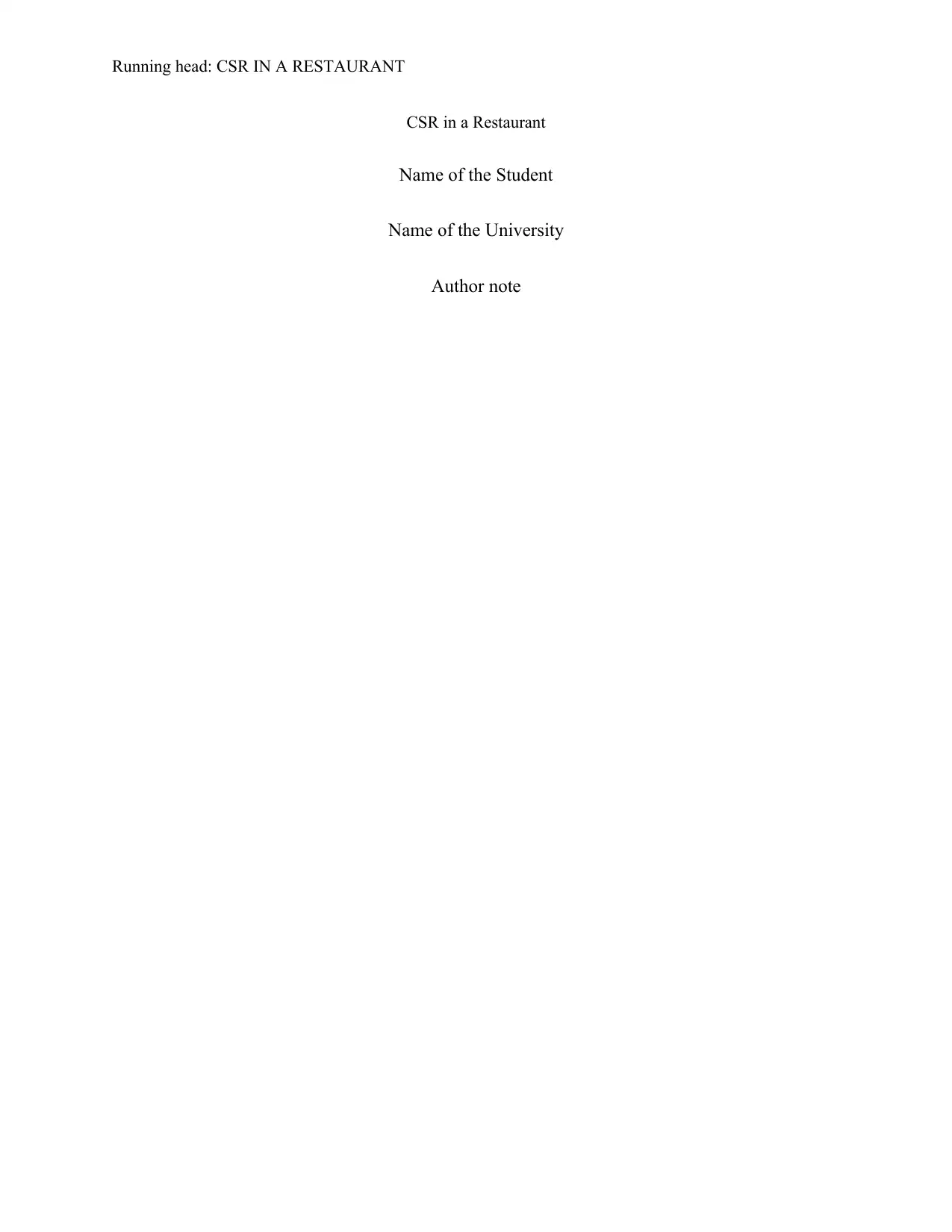
Running head: CSR IN A RESTAURANT
CSR in a Restaurant
Name of the Student
Name of the University
Author note
CSR in a Restaurant
Name of the Student
Name of the University
Author note
Paraphrase This Document
Need a fresh take? Get an instant paraphrase of this document with our AI Paraphraser
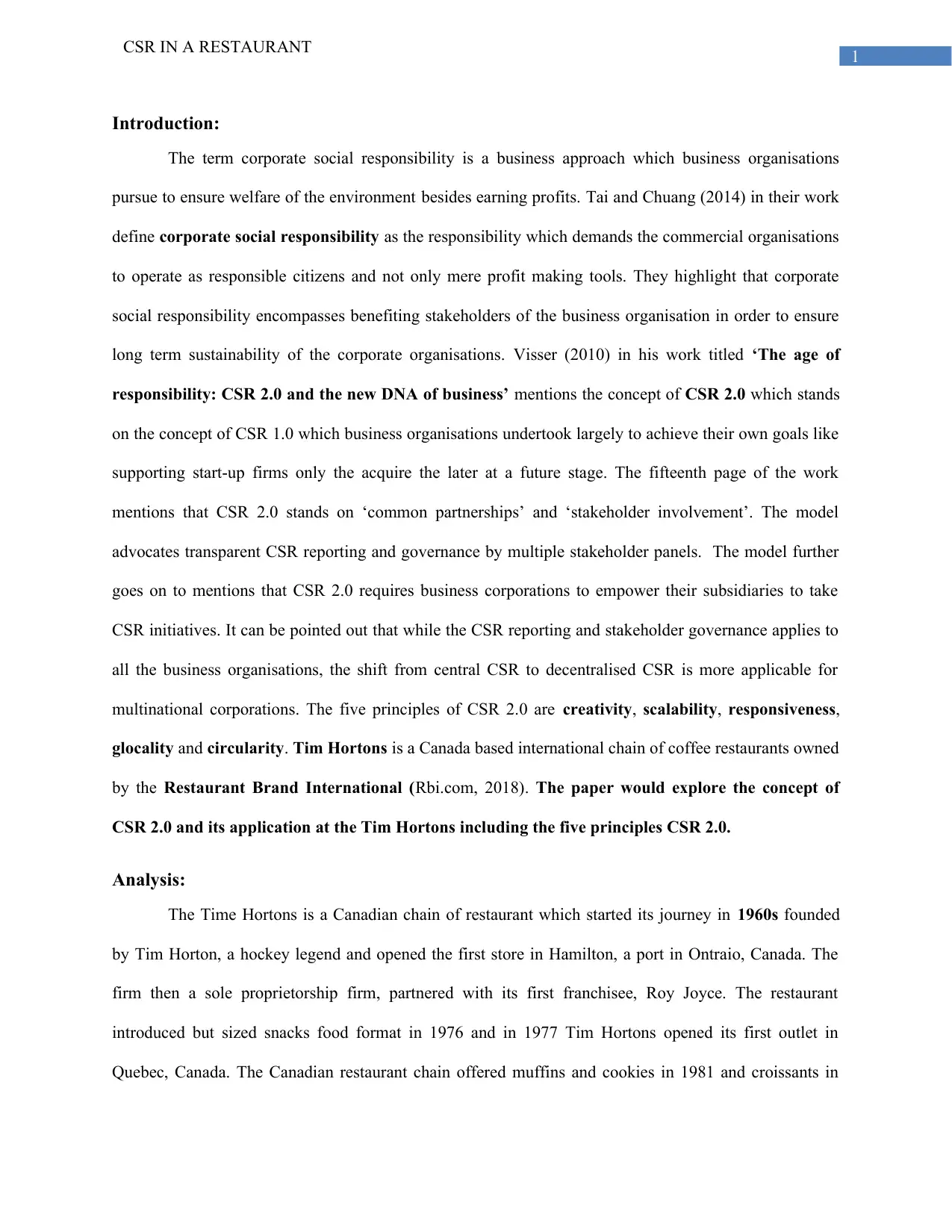
1
CSR IN A RESTAURANT
Introduction:
The term corporate social responsibility is a business approach which business organisations
pursue to ensure welfare of the environment besides earning profits. Tai and Chuang (2014) in their work
define corporate social responsibility as the responsibility which demands the commercial organisations
to operate as responsible citizens and not only mere profit making tools. They highlight that corporate
social responsibility encompasses benefiting stakeholders of the business organisation in order to ensure
long term sustainability of the corporate organisations. Visser (2010) in his work titled ‘The age of
responsibility: CSR 2.0 and the new DNA of business’ mentions the concept of CSR 2.0 which stands
on the concept of CSR 1.0 which business organisations undertook largely to achieve their own goals like
supporting start-up firms only the acquire the later at a future stage. The fifteenth page of the work
mentions that CSR 2.0 stands on ‘common partnerships’ and ‘stakeholder involvement’. The model
advocates transparent CSR reporting and governance by multiple stakeholder panels. The model further
goes on to mentions that CSR 2.0 requires business corporations to empower their subsidiaries to take
CSR initiatives. It can be pointed out that while the CSR reporting and stakeholder governance applies to
all the business organisations, the shift from central CSR to decentralised CSR is more applicable for
multinational corporations. The five principles of CSR 2.0 are creativity, scalability, responsiveness,
glocality and circularity. Tim Hortons is a Canada based international chain of coffee restaurants owned
by the Restaurant Brand International (Rbi.com, 2018). The paper would explore the concept of
CSR 2.0 and its application at the Tim Hortons including the five principles CSR 2.0.
Analysis:
The Time Hortons is a Canadian chain of restaurant which started its journey in 1960s founded
by Tim Horton, a hockey legend and opened the first store in Hamilton, a port in Ontraio, Canada. The
firm then a sole proprietorship firm, partnered with its first franchisee, Roy Joyce. The restaurant
introduced but sized snacks food format in 1976 and in 1977 Tim Hortons opened its first outlet in
Quebec, Canada. The Canadian restaurant chain offered muffins and cookies in 1981 and croissants in
CSR IN A RESTAURANT
Introduction:
The term corporate social responsibility is a business approach which business organisations
pursue to ensure welfare of the environment besides earning profits. Tai and Chuang (2014) in their work
define corporate social responsibility as the responsibility which demands the commercial organisations
to operate as responsible citizens and not only mere profit making tools. They highlight that corporate
social responsibility encompasses benefiting stakeholders of the business organisation in order to ensure
long term sustainability of the corporate organisations. Visser (2010) in his work titled ‘The age of
responsibility: CSR 2.0 and the new DNA of business’ mentions the concept of CSR 2.0 which stands
on the concept of CSR 1.0 which business organisations undertook largely to achieve their own goals like
supporting start-up firms only the acquire the later at a future stage. The fifteenth page of the work
mentions that CSR 2.0 stands on ‘common partnerships’ and ‘stakeholder involvement’. The model
advocates transparent CSR reporting and governance by multiple stakeholder panels. The model further
goes on to mentions that CSR 2.0 requires business corporations to empower their subsidiaries to take
CSR initiatives. It can be pointed out that while the CSR reporting and stakeholder governance applies to
all the business organisations, the shift from central CSR to decentralised CSR is more applicable for
multinational corporations. The five principles of CSR 2.0 are creativity, scalability, responsiveness,
glocality and circularity. Tim Hortons is a Canada based international chain of coffee restaurants owned
by the Restaurant Brand International (Rbi.com, 2018). The paper would explore the concept of
CSR 2.0 and its application at the Tim Hortons including the five principles CSR 2.0.
Analysis:
The Time Hortons is a Canadian chain of restaurant which started its journey in 1960s founded
by Tim Horton, a hockey legend and opened the first store in Hamilton, a port in Ontraio, Canada. The
firm then a sole proprietorship firm, partnered with its first franchisee, Roy Joyce. The restaurant
introduced but sized snacks food format in 1976 and in 1977 Tim Hortons opened its first outlet in
Quebec, Canada. The Canadian restaurant chain offered muffins and cookies in 1981 and croissants in
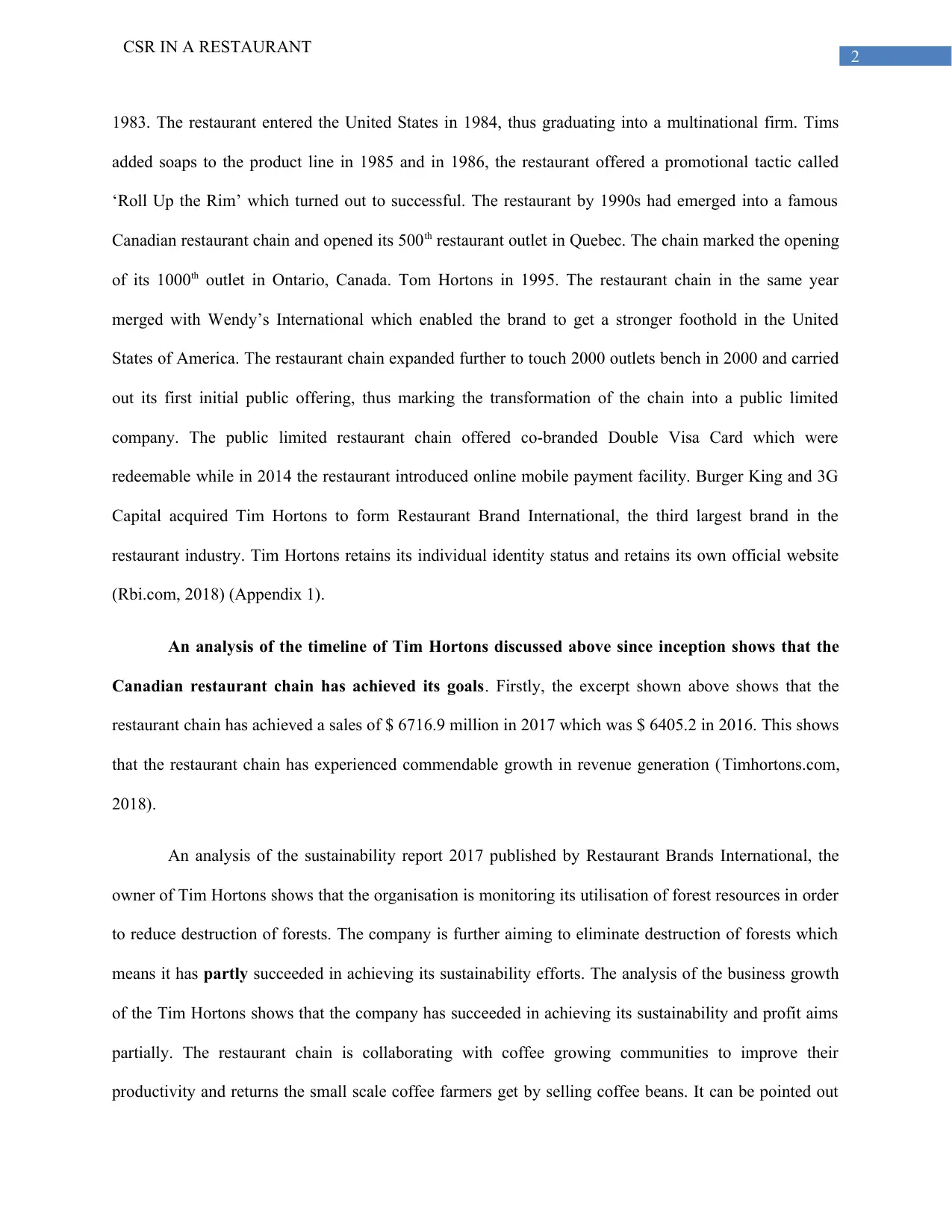
2
CSR IN A RESTAURANT
1983. The restaurant entered the United States in 1984, thus graduating into a multinational firm. Tims
added soaps to the product line in 1985 and in 1986, the restaurant offered a promotional tactic called
‘Roll Up the Rim’ which turned out to successful. The restaurant by 1990s had emerged into a famous
Canadian restaurant chain and opened its 500th restaurant outlet in Quebec. The chain marked the opening
of its 1000th outlet in Ontario, Canada. Tom Hortons in 1995. The restaurant chain in the same year
merged with Wendy’s International which enabled the brand to get a stronger foothold in the United
States of America. The restaurant chain expanded further to touch 2000 outlets bench in 2000 and carried
out its first initial public offering, thus marking the transformation of the chain into a public limited
company. The public limited restaurant chain offered co-branded Double Visa Card which were
redeemable while in 2014 the restaurant introduced online mobile payment facility. Burger King and 3G
Capital acquired Tim Hortons to form Restaurant Brand International, the third largest brand in the
restaurant industry. Tim Hortons retains its individual identity status and retains its own official website
(Rbi.com, 2018) (Appendix 1).
An analysis of the timeline of Tim Hortons discussed above since inception shows that the
Canadian restaurant chain has achieved its goals. Firstly, the excerpt shown above shows that the
restaurant chain has achieved a sales of $ 6716.9 million in 2017 which was $ 6405.2 in 2016. This shows
that the restaurant chain has experienced commendable growth in revenue generation (Timhortons.com,
2018).
An analysis of the sustainability report 2017 published by Restaurant Brands International, the
owner of Tim Hortons shows that the organisation is monitoring its utilisation of forest resources in order
to reduce destruction of forests. The company is further aiming to eliminate destruction of forests which
means it has partly succeeded in achieving its sustainability efforts. The analysis of the business growth
of the Tim Hortons shows that the company has succeeded in achieving its sustainability and profit aims
partially. The restaurant chain is collaborating with coffee growing communities to improve their
productivity and returns the small scale coffee farmers get by selling coffee beans. It can be pointed out
CSR IN A RESTAURANT
1983. The restaurant entered the United States in 1984, thus graduating into a multinational firm. Tims
added soaps to the product line in 1985 and in 1986, the restaurant offered a promotional tactic called
‘Roll Up the Rim’ which turned out to successful. The restaurant by 1990s had emerged into a famous
Canadian restaurant chain and opened its 500th restaurant outlet in Quebec. The chain marked the opening
of its 1000th outlet in Ontario, Canada. Tom Hortons in 1995. The restaurant chain in the same year
merged with Wendy’s International which enabled the brand to get a stronger foothold in the United
States of America. The restaurant chain expanded further to touch 2000 outlets bench in 2000 and carried
out its first initial public offering, thus marking the transformation of the chain into a public limited
company. The public limited restaurant chain offered co-branded Double Visa Card which were
redeemable while in 2014 the restaurant introduced online mobile payment facility. Burger King and 3G
Capital acquired Tim Hortons to form Restaurant Brand International, the third largest brand in the
restaurant industry. Tim Hortons retains its individual identity status and retains its own official website
(Rbi.com, 2018) (Appendix 1).
An analysis of the timeline of Tim Hortons discussed above since inception shows that the
Canadian restaurant chain has achieved its goals. Firstly, the excerpt shown above shows that the
restaurant chain has achieved a sales of $ 6716.9 million in 2017 which was $ 6405.2 in 2016. This shows
that the restaurant chain has experienced commendable growth in revenue generation (Timhortons.com,
2018).
An analysis of the sustainability report 2017 published by Restaurant Brands International, the
owner of Tim Hortons shows that the organisation is monitoring its utilisation of forest resources in order
to reduce destruction of forests. The company is further aiming to eliminate destruction of forests which
means it has partly succeeded in achieving its sustainability efforts. The analysis of the business growth
of the Tim Hortons shows that the company has succeeded in achieving its sustainability and profit aims
partially. The restaurant chain is collaborating with coffee growing communities to improve their
productivity and returns the small scale coffee farmers get by selling coffee beans. It can be pointed out
⊘ This is a preview!⊘
Do you want full access?
Subscribe today to unlock all pages.

Trusted by 1+ million students worldwide
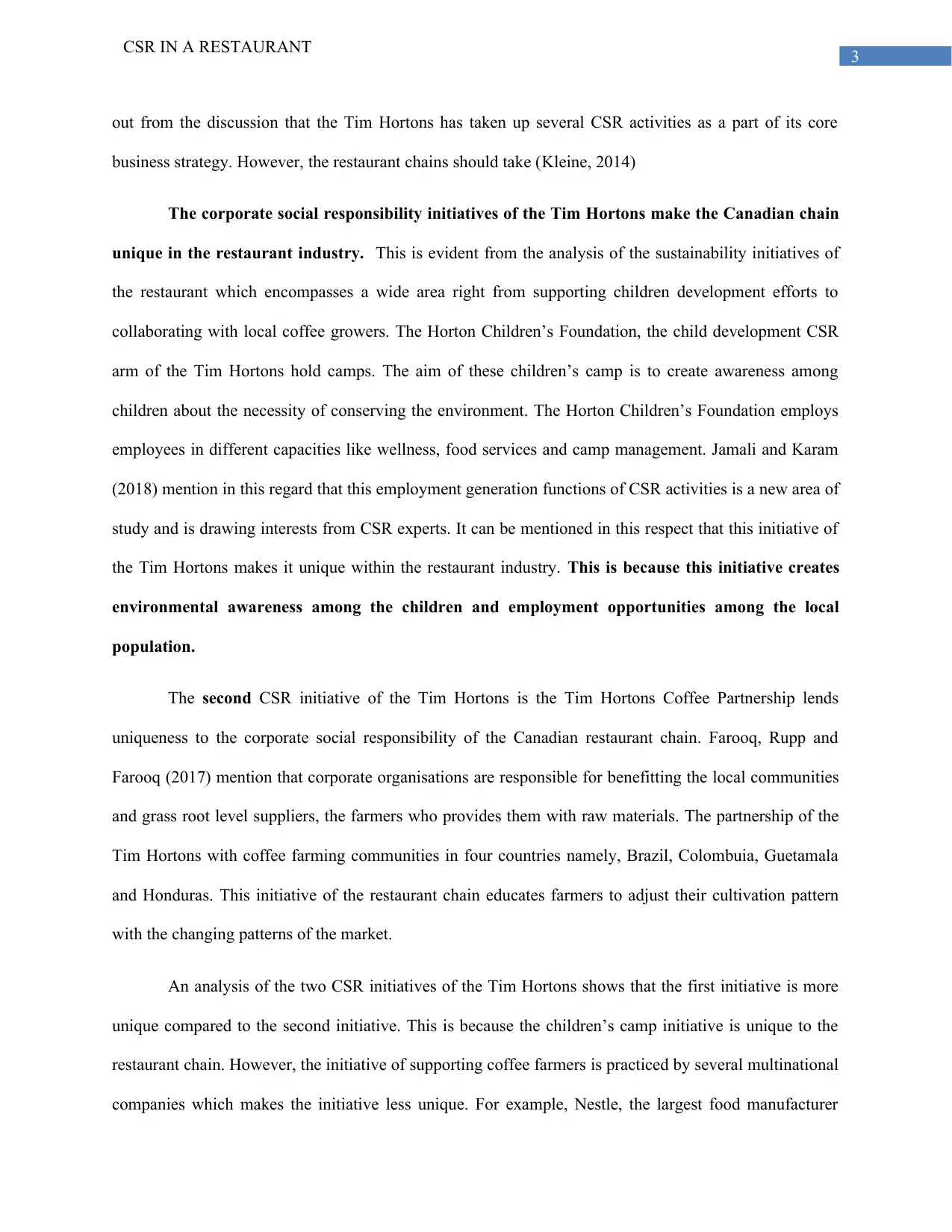
3
CSR IN A RESTAURANT
out from the discussion that the Tim Hortons has taken up several CSR activities as a part of its core
business strategy. However, the restaurant chains should take (Kleine, 2014)
The corporate social responsibility initiatives of the Tim Hortons make the Canadian chain
unique in the restaurant industry. This is evident from the analysis of the sustainability initiatives of
the restaurant which encompasses a wide area right from supporting children development efforts to
collaborating with local coffee growers. The Horton Children’s Foundation, the child development CSR
arm of the Tim Hortons hold camps. The aim of these children’s camp is to create awareness among
children about the necessity of conserving the environment. The Horton Children’s Foundation employs
employees in different capacities like wellness, food services and camp management. Jamali and Karam
(2018) mention in this regard that this employment generation functions of CSR activities is a new area of
study and is drawing interests from CSR experts. It can be mentioned in this respect that this initiative of
the Tim Hortons makes it unique within the restaurant industry. This is because this initiative creates
environmental awareness among the children and employment opportunities among the local
population.
The second CSR initiative of the Tim Hortons is the Tim Hortons Coffee Partnership lends
uniqueness to the corporate social responsibility of the Canadian restaurant chain. Farooq, Rupp and
Farooq (2017) mention that corporate organisations are responsible for benefitting the local communities
and grass root level suppliers, the farmers who provides them with raw materials. The partnership of the
Tim Hortons with coffee farming communities in four countries namely, Brazil, Colombuia, Guetamala
and Honduras. This initiative of the restaurant chain educates farmers to adjust their cultivation pattern
with the changing patterns of the market.
An analysis of the two CSR initiatives of the Tim Hortons shows that the first initiative is more
unique compared to the second initiative. This is because the children’s camp initiative is unique to the
restaurant chain. However, the initiative of supporting coffee farmers is practiced by several multinational
companies which makes the initiative less unique. For example, Nestle, the largest food manufacturer
CSR IN A RESTAURANT
out from the discussion that the Tim Hortons has taken up several CSR activities as a part of its core
business strategy. However, the restaurant chains should take (Kleine, 2014)
The corporate social responsibility initiatives of the Tim Hortons make the Canadian chain
unique in the restaurant industry. This is evident from the analysis of the sustainability initiatives of
the restaurant which encompasses a wide area right from supporting children development efforts to
collaborating with local coffee growers. The Horton Children’s Foundation, the child development CSR
arm of the Tim Hortons hold camps. The aim of these children’s camp is to create awareness among
children about the necessity of conserving the environment. The Horton Children’s Foundation employs
employees in different capacities like wellness, food services and camp management. Jamali and Karam
(2018) mention in this regard that this employment generation functions of CSR activities is a new area of
study and is drawing interests from CSR experts. It can be mentioned in this respect that this initiative of
the Tim Hortons makes it unique within the restaurant industry. This is because this initiative creates
environmental awareness among the children and employment opportunities among the local
population.
The second CSR initiative of the Tim Hortons is the Tim Hortons Coffee Partnership lends
uniqueness to the corporate social responsibility of the Canadian restaurant chain. Farooq, Rupp and
Farooq (2017) mention that corporate organisations are responsible for benefitting the local communities
and grass root level suppliers, the farmers who provides them with raw materials. The partnership of the
Tim Hortons with coffee farming communities in four countries namely, Brazil, Colombuia, Guetamala
and Honduras. This initiative of the restaurant chain educates farmers to adjust their cultivation pattern
with the changing patterns of the market.
An analysis of the two CSR initiatives of the Tim Hortons shows that the first initiative is more
unique compared to the second initiative. This is because the children’s camp initiative is unique to the
restaurant chain. However, the initiative of supporting coffee farmers is practiced by several multinational
companies which makes the initiative less unique. For example, Nestle, the largest food manufacturer
Paraphrase This Document
Need a fresh take? Get an instant paraphrase of this document with our AI Paraphraser
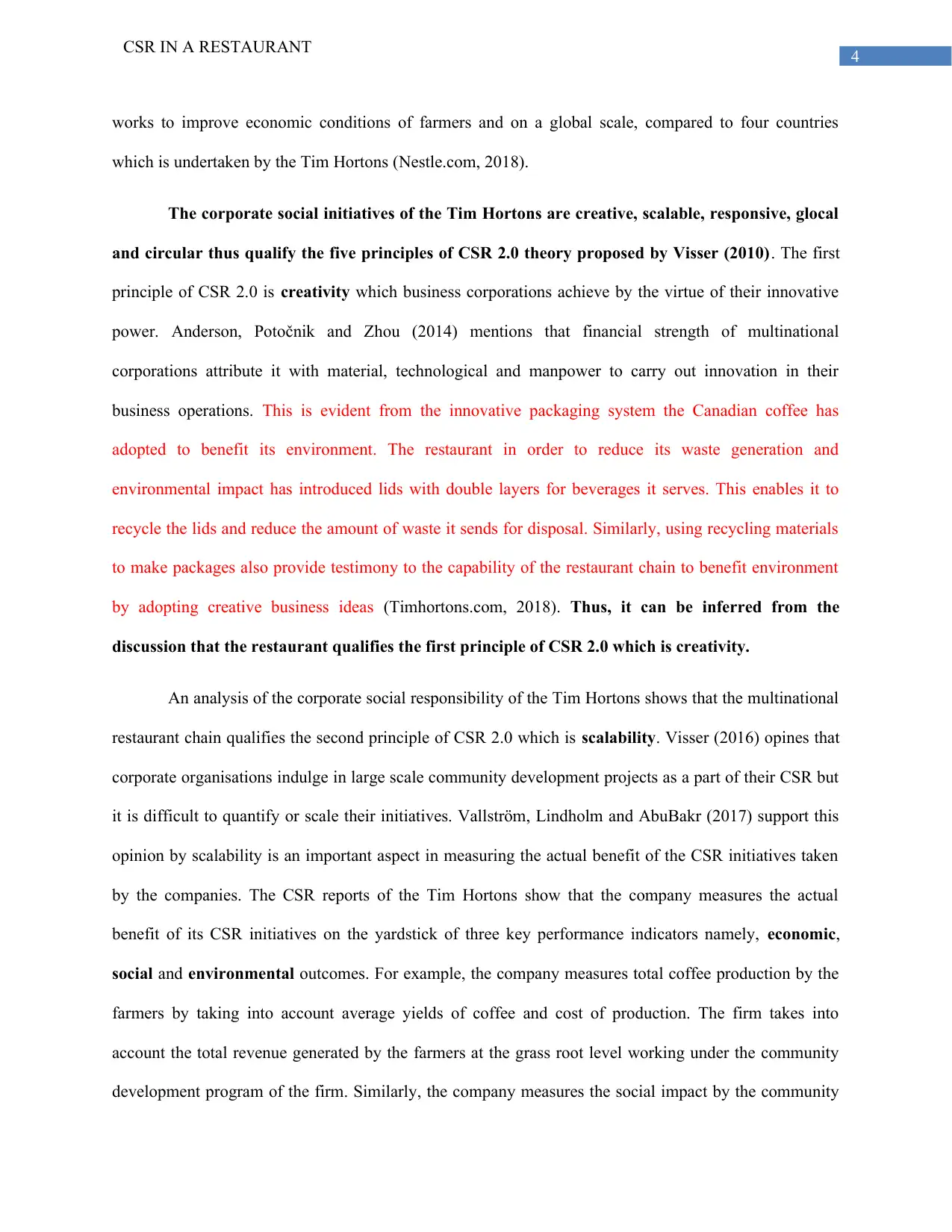
4
CSR IN A RESTAURANT
works to improve economic conditions of farmers and on a global scale, compared to four countries
which is undertaken by the Tim Hortons (Nestle.com, 2018).
The corporate social initiatives of the Tim Hortons are creative, scalable, responsive, glocal
and circular thus qualify the five principles of CSR 2.0 theory proposed by Visser (2010). The first
principle of CSR 2.0 is creativity which business corporations achieve by the virtue of their innovative
power. Anderson, Potočnik and Zhou (2014) mentions that financial strength of multinational
corporations attribute it with material, technological and manpower to carry out innovation in their
business operations. This is evident from the innovative packaging system the Canadian coffee has
adopted to benefit its environment. The restaurant in order to reduce its waste generation and
environmental impact has introduced lids with double layers for beverages it serves. This enables it to
recycle the lids and reduce the amount of waste it sends for disposal. Similarly, using recycling materials
to make packages also provide testimony to the capability of the restaurant chain to benefit environment
by adopting creative business ideas (Timhortons.com, 2018). Thus, it can be inferred from the
discussion that the restaurant qualifies the first principle of CSR 2.0 which is creativity.
An analysis of the corporate social responsibility of the Tim Hortons shows that the multinational
restaurant chain qualifies the second principle of CSR 2.0 which is scalability. Visser (2016) opines that
corporate organisations indulge in large scale community development projects as a part of their CSR but
it is difficult to quantify or scale their initiatives. Vallström, Lindholm and AbuBakr (2017) support this
opinion by scalability is an important aspect in measuring the actual benefit of the CSR initiatives taken
by the companies. The CSR reports of the Tim Hortons show that the company measures the actual
benefit of its CSR initiatives on the yardstick of three key performance indicators namely, economic,
social and environmental outcomes. For example, the company measures total coffee production by the
farmers by taking into account average yields of coffee and cost of production. The firm takes into
account the total revenue generated by the farmers at the grass root level working under the community
development program of the firm. Similarly, the company measures the social impact by the community
CSR IN A RESTAURANT
works to improve economic conditions of farmers and on a global scale, compared to four countries
which is undertaken by the Tim Hortons (Nestle.com, 2018).
The corporate social initiatives of the Tim Hortons are creative, scalable, responsive, glocal
and circular thus qualify the five principles of CSR 2.0 theory proposed by Visser (2010). The first
principle of CSR 2.0 is creativity which business corporations achieve by the virtue of their innovative
power. Anderson, Potočnik and Zhou (2014) mentions that financial strength of multinational
corporations attribute it with material, technological and manpower to carry out innovation in their
business operations. This is evident from the innovative packaging system the Canadian coffee has
adopted to benefit its environment. The restaurant in order to reduce its waste generation and
environmental impact has introduced lids with double layers for beverages it serves. This enables it to
recycle the lids and reduce the amount of waste it sends for disposal. Similarly, using recycling materials
to make packages also provide testimony to the capability of the restaurant chain to benefit environment
by adopting creative business ideas (Timhortons.com, 2018). Thus, it can be inferred from the
discussion that the restaurant qualifies the first principle of CSR 2.0 which is creativity.
An analysis of the corporate social responsibility of the Tim Hortons shows that the multinational
restaurant chain qualifies the second principle of CSR 2.0 which is scalability. Visser (2016) opines that
corporate organisations indulge in large scale community development projects as a part of their CSR but
it is difficult to quantify or scale their initiatives. Vallström, Lindholm and AbuBakr (2017) support this
opinion by scalability is an important aspect in measuring the actual benefit of the CSR initiatives taken
by the companies. The CSR reports of the Tim Hortons show that the company measures the actual
benefit of its CSR initiatives on the yardstick of three key performance indicators namely, economic,
social and environmental outcomes. For example, the company measures total coffee production by the
farmers by taking into account average yields of coffee and cost of production. The firm takes into
account the total revenue generated by the farmers at the grass root level working under the community
development program of the firm. Similarly, the company measures the social impact by the community
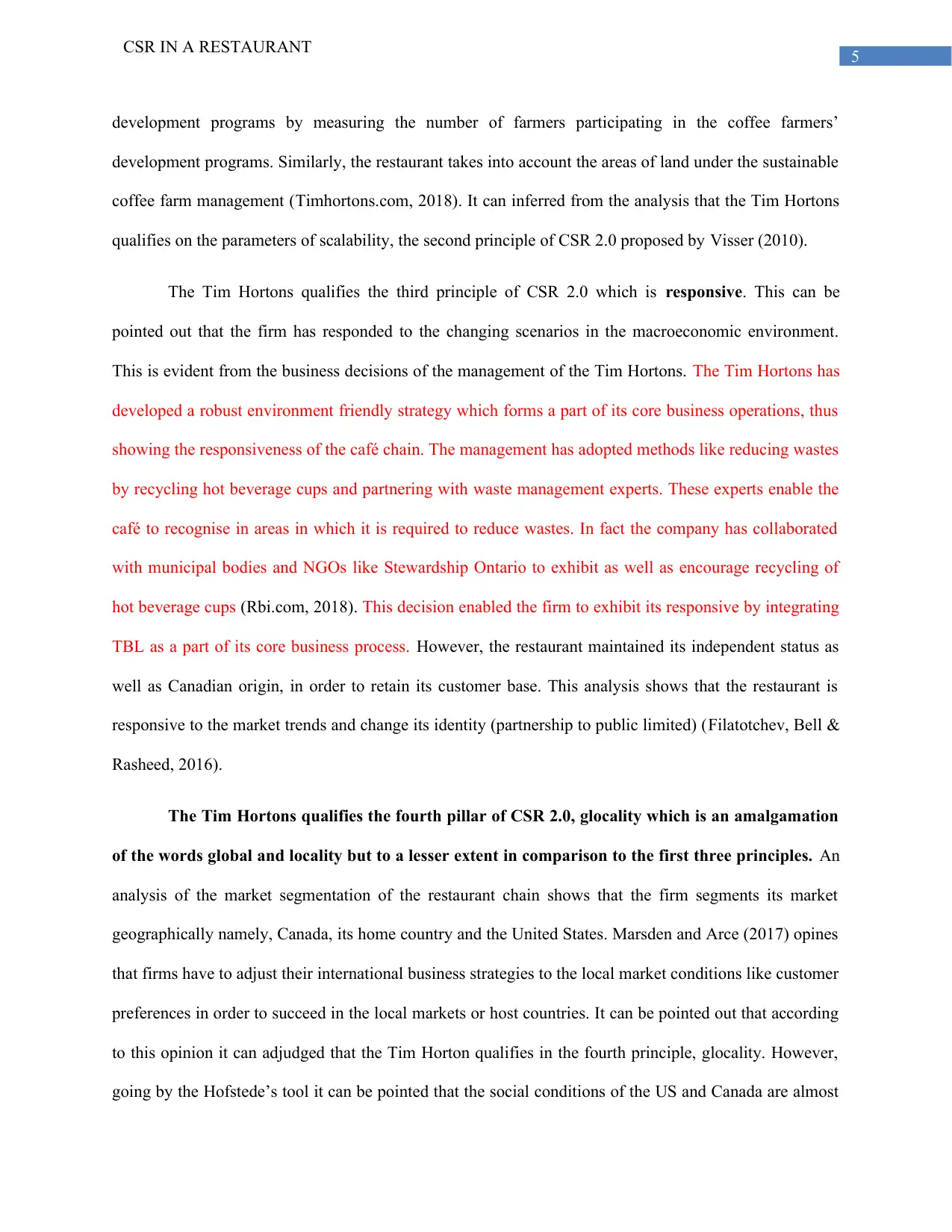
5
CSR IN A RESTAURANT
development programs by measuring the number of farmers participating in the coffee farmers’
development programs. Similarly, the restaurant takes into account the areas of land under the sustainable
coffee farm management (Timhortons.com, 2018). It can inferred from the analysis that the Tim Hortons
qualifies on the parameters of scalability, the second principle of CSR 2.0 proposed by Visser (2010).
The Tim Hortons qualifies the third principle of CSR 2.0 which is responsive. This can be
pointed out that the firm has responded to the changing scenarios in the macroeconomic environment.
This is evident from the business decisions of the management of the Tim Hortons. The Tim Hortons has
developed a robust environment friendly strategy which forms a part of its core business operations, thus
showing the responsiveness of the café chain. The management has adopted methods like reducing wastes
by recycling hot beverage cups and partnering with waste management experts. These experts enable the
café to recognise in areas in which it is required to reduce wastes. In fact the company has collaborated
with municipal bodies and NGOs like Stewardship Ontario to exhibit as well as encourage recycling of
hot beverage cups (Rbi.com, 2018). This decision enabled the firm to exhibit its responsive by integrating
TBL as a part of its core business process. However, the restaurant maintained its independent status as
well as Canadian origin, in order to retain its customer base. This analysis shows that the restaurant is
responsive to the market trends and change its identity (partnership to public limited) (Filatotchev, Bell &
Rasheed, 2016).
The Tim Hortons qualifies the fourth pillar of CSR 2.0, glocality which is an amalgamation
of the words global and locality but to a lesser extent in comparison to the first three principles. An
analysis of the market segmentation of the restaurant chain shows that the firm segments its market
geographically namely, Canada, its home country and the United States. Marsden and Arce (2017) opines
that firms have to adjust their international business strategies to the local market conditions like customer
preferences in order to succeed in the local markets or host countries. It can be pointed out that according
to this opinion it can adjudged that the Tim Horton qualifies in the fourth principle, glocality. However,
going by the Hofstede’s tool it can be pointed that the social conditions of the US and Canada are almost
CSR IN A RESTAURANT
development programs by measuring the number of farmers participating in the coffee farmers’
development programs. Similarly, the restaurant takes into account the areas of land under the sustainable
coffee farm management (Timhortons.com, 2018). It can inferred from the analysis that the Tim Hortons
qualifies on the parameters of scalability, the second principle of CSR 2.0 proposed by Visser (2010).
The Tim Hortons qualifies the third principle of CSR 2.0 which is responsive. This can be
pointed out that the firm has responded to the changing scenarios in the macroeconomic environment.
This is evident from the business decisions of the management of the Tim Hortons. The Tim Hortons has
developed a robust environment friendly strategy which forms a part of its core business operations, thus
showing the responsiveness of the café chain. The management has adopted methods like reducing wastes
by recycling hot beverage cups and partnering with waste management experts. These experts enable the
café to recognise in areas in which it is required to reduce wastes. In fact the company has collaborated
with municipal bodies and NGOs like Stewardship Ontario to exhibit as well as encourage recycling of
hot beverage cups (Rbi.com, 2018). This decision enabled the firm to exhibit its responsive by integrating
TBL as a part of its core business process. However, the restaurant maintained its independent status as
well as Canadian origin, in order to retain its customer base. This analysis shows that the restaurant is
responsive to the market trends and change its identity (partnership to public limited) (Filatotchev, Bell &
Rasheed, 2016).
The Tim Hortons qualifies the fourth pillar of CSR 2.0, glocality which is an amalgamation
of the words global and locality but to a lesser extent in comparison to the first three principles. An
analysis of the market segmentation of the restaurant chain shows that the firm segments its market
geographically namely, Canada, its home country and the United States. Marsden and Arce (2017) opines
that firms have to adjust their international business strategies to the local market conditions like customer
preferences in order to succeed in the local markets or host countries. It can be pointed out that according
to this opinion it can adjudged that the Tim Horton qualifies in the fourth principle, glocality. However,
going by the Hofstede’s tool it can be pointed that the social conditions of the US and Canada are almost
⊘ This is a preview!⊘
Do you want full access?
Subscribe today to unlock all pages.

Trusted by 1+ million students worldwide
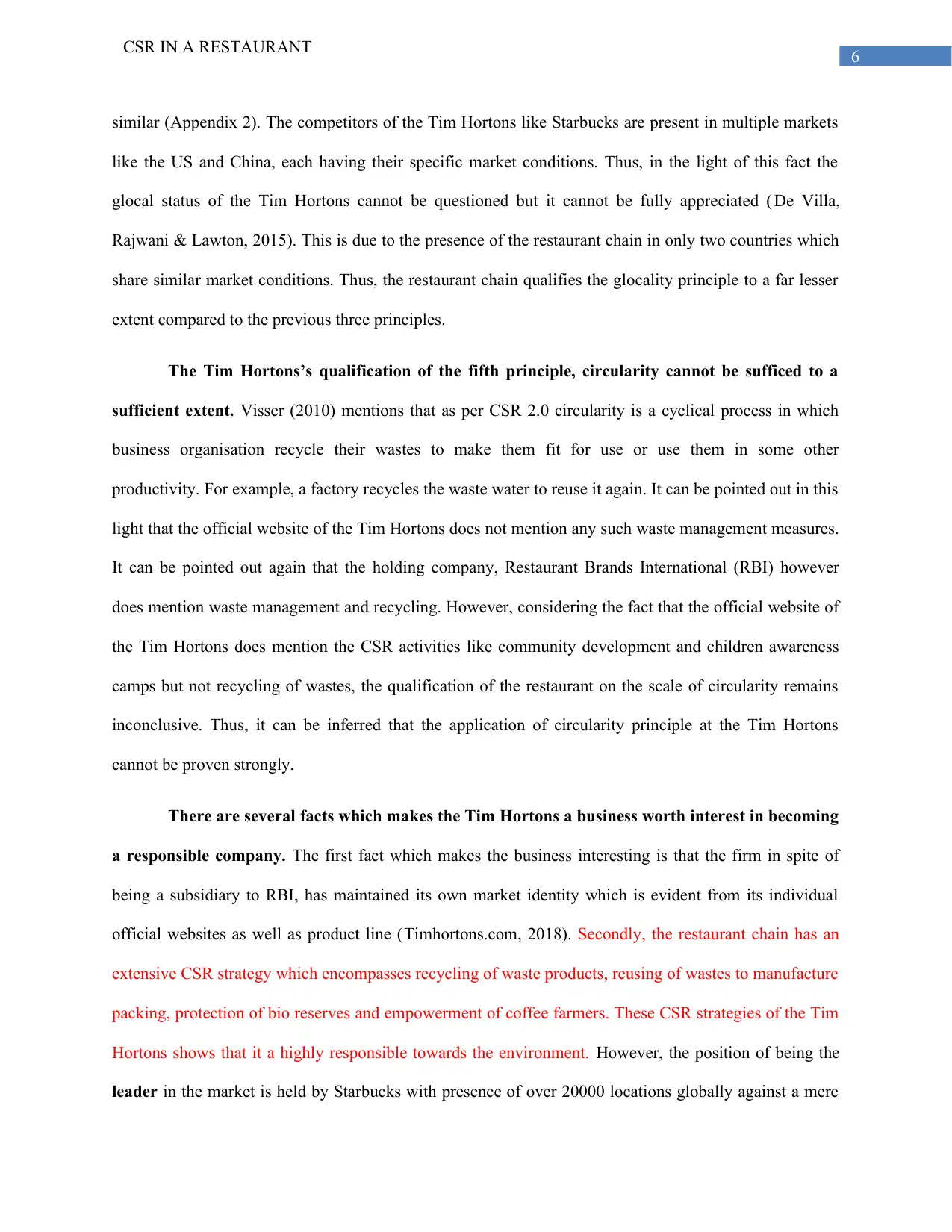
6
CSR IN A RESTAURANT
similar (Appendix 2). The competitors of the Tim Hortons like Starbucks are present in multiple markets
like the US and China, each having their specific market conditions. Thus, in the light of this fact the
glocal status of the Tim Hortons cannot be questioned but it cannot be fully appreciated ( De Villa,
Rajwani & Lawton, 2015). This is due to the presence of the restaurant chain in only two countries which
share similar market conditions. Thus, the restaurant chain qualifies the glocality principle to a far lesser
extent compared to the previous three principles.
The Tim Hortons’s qualification of the fifth principle, circularity cannot be sufficed to a
sufficient extent. Visser (2010) mentions that as per CSR 2.0 circularity is a cyclical process in which
business organisation recycle their wastes to make them fit for use or use them in some other
productivity. For example, a factory recycles the waste water to reuse it again. It can be pointed out in this
light that the official website of the Tim Hortons does not mention any such waste management measures.
It can be pointed out again that the holding company, Restaurant Brands International (RBI) however
does mention waste management and recycling. However, considering the fact that the official website of
the Tim Hortons does mention the CSR activities like community development and children awareness
camps but not recycling of wastes, the qualification of the restaurant on the scale of circularity remains
inconclusive. Thus, it can be inferred that the application of circularity principle at the Tim Hortons
cannot be proven strongly.
There are several facts which makes the Tim Hortons a business worth interest in becoming
a responsible company. The first fact which makes the business interesting is that the firm in spite of
being a subsidiary to RBI, has maintained its own market identity which is evident from its individual
official websites as well as product line (Timhortons.com, 2018). Secondly, the restaurant chain has an
extensive CSR strategy which encompasses recycling of waste products, reusing of wastes to manufacture
packing, protection of bio reserves and empowerment of coffee farmers. These CSR strategies of the Tim
Hortons shows that it a highly responsible towards the environment. However, the position of being the
leader in the market is held by Starbucks with presence of over 20000 locations globally against a mere
CSR IN A RESTAURANT
similar (Appendix 2). The competitors of the Tim Hortons like Starbucks are present in multiple markets
like the US and China, each having their specific market conditions. Thus, in the light of this fact the
glocal status of the Tim Hortons cannot be questioned but it cannot be fully appreciated ( De Villa,
Rajwani & Lawton, 2015). This is due to the presence of the restaurant chain in only two countries which
share similar market conditions. Thus, the restaurant chain qualifies the glocality principle to a far lesser
extent compared to the previous three principles.
The Tim Hortons’s qualification of the fifth principle, circularity cannot be sufficed to a
sufficient extent. Visser (2010) mentions that as per CSR 2.0 circularity is a cyclical process in which
business organisation recycle their wastes to make them fit for use or use them in some other
productivity. For example, a factory recycles the waste water to reuse it again. It can be pointed out in this
light that the official website of the Tim Hortons does not mention any such waste management measures.
It can be pointed out again that the holding company, Restaurant Brands International (RBI) however
does mention waste management and recycling. However, considering the fact that the official website of
the Tim Hortons does mention the CSR activities like community development and children awareness
camps but not recycling of wastes, the qualification of the restaurant on the scale of circularity remains
inconclusive. Thus, it can be inferred that the application of circularity principle at the Tim Hortons
cannot be proven strongly.
There are several facts which makes the Tim Hortons a business worth interest in becoming
a responsible company. The first fact which makes the business interesting is that the firm in spite of
being a subsidiary to RBI, has maintained its own market identity which is evident from its individual
official websites as well as product line (Timhortons.com, 2018). Secondly, the restaurant chain has an
extensive CSR strategy which encompasses recycling of waste products, reusing of wastes to manufacture
packing, protection of bio reserves and empowerment of coffee farmers. These CSR strategies of the Tim
Hortons shows that it a highly responsible towards the environment. However, the position of being the
leader in the market is held by Starbucks with presence of over 20000 locations globally against a mere
Paraphrase This Document
Need a fresh take? Get an instant paraphrase of this document with our AI Paraphraser
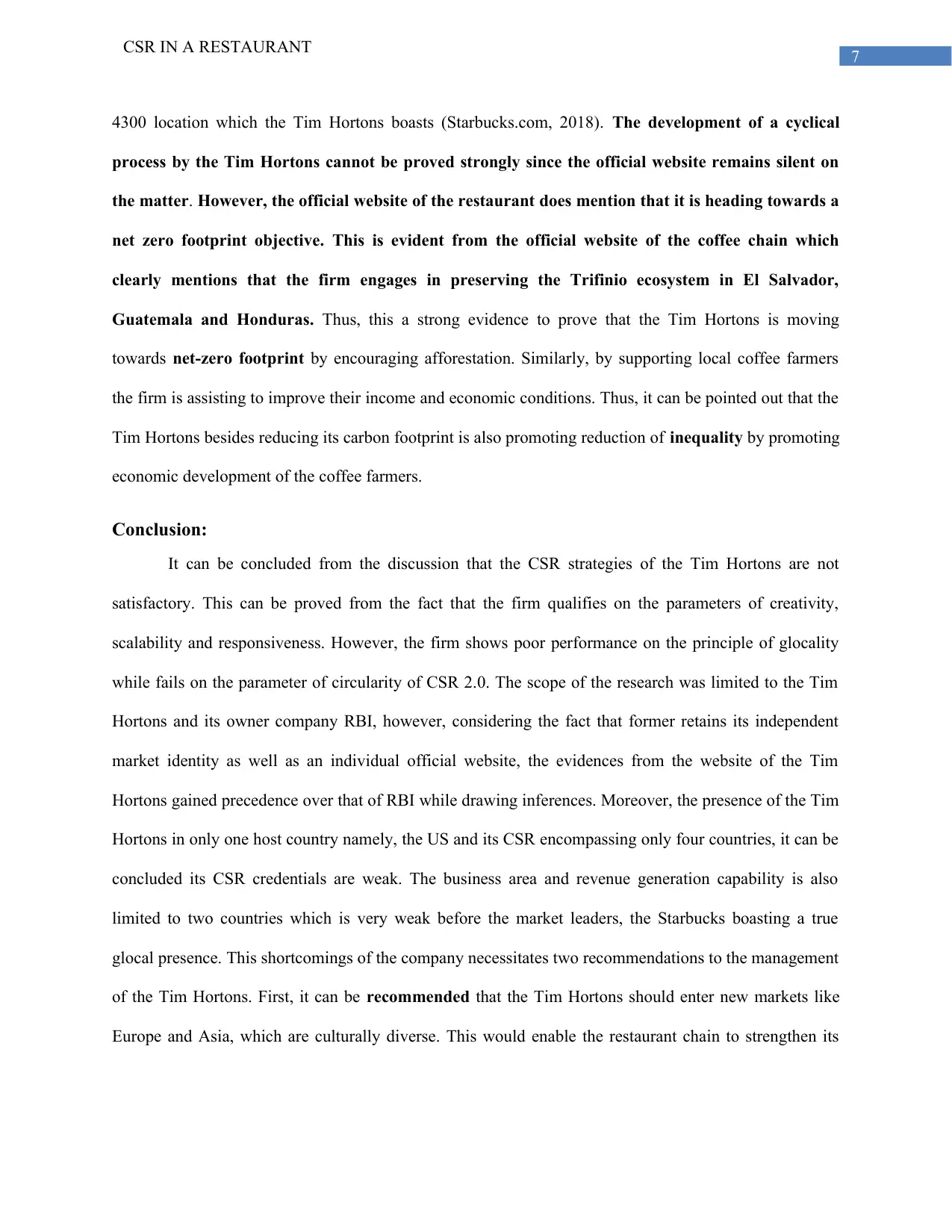
7
CSR IN A RESTAURANT
4300 location which the Tim Hortons boasts (Starbucks.com, 2018). The development of a cyclical
process by the Tim Hortons cannot be proved strongly since the official website remains silent on
the matter. However, the official website of the restaurant does mention that it is heading towards a
net zero footprint objective. This is evident from the official website of the coffee chain which
clearly mentions that the firm engages in preserving the Trifinio ecosystem in El Salvador,
Guatemala and Honduras. Thus, this a strong evidence to prove that the Tim Hortons is moving
towards net-zero footprint by encouraging afforestation. Similarly, by supporting local coffee farmers
the firm is assisting to improve their income and economic conditions. Thus, it can be pointed out that the
Tim Hortons besides reducing its carbon footprint is also promoting reduction of inequality by promoting
economic development of the coffee farmers.
Conclusion:
It can be concluded from the discussion that the CSR strategies of the Tim Hortons are not
satisfactory. This can be proved from the fact that the firm qualifies on the parameters of creativity,
scalability and responsiveness. However, the firm shows poor performance on the principle of glocality
while fails on the parameter of circularity of CSR 2.0. The scope of the research was limited to the Tim
Hortons and its owner company RBI, however, considering the fact that former retains its independent
market identity as well as an individual official website, the evidences from the website of the Tim
Hortons gained precedence over that of RBI while drawing inferences. Moreover, the presence of the Tim
Hortons in only one host country namely, the US and its CSR encompassing only four countries, it can be
concluded its CSR credentials are weak. The business area and revenue generation capability is also
limited to two countries which is very weak before the market leaders, the Starbucks boasting a true
glocal presence. This shortcomings of the company necessitates two recommendations to the management
of the Tim Hortons. First, it can be recommended that the Tim Hortons should enter new markets like
Europe and Asia, which are culturally diverse. This would enable the restaurant chain to strengthen its
CSR IN A RESTAURANT
4300 location which the Tim Hortons boasts (Starbucks.com, 2018). The development of a cyclical
process by the Tim Hortons cannot be proved strongly since the official website remains silent on
the matter. However, the official website of the restaurant does mention that it is heading towards a
net zero footprint objective. This is evident from the official website of the coffee chain which
clearly mentions that the firm engages in preserving the Trifinio ecosystem in El Salvador,
Guatemala and Honduras. Thus, this a strong evidence to prove that the Tim Hortons is moving
towards net-zero footprint by encouraging afforestation. Similarly, by supporting local coffee farmers
the firm is assisting to improve their income and economic conditions. Thus, it can be pointed out that the
Tim Hortons besides reducing its carbon footprint is also promoting reduction of inequality by promoting
economic development of the coffee farmers.
Conclusion:
It can be concluded from the discussion that the CSR strategies of the Tim Hortons are not
satisfactory. This can be proved from the fact that the firm qualifies on the parameters of creativity,
scalability and responsiveness. However, the firm shows poor performance on the principle of glocality
while fails on the parameter of circularity of CSR 2.0. The scope of the research was limited to the Tim
Hortons and its owner company RBI, however, considering the fact that former retains its independent
market identity as well as an individual official website, the evidences from the website of the Tim
Hortons gained precedence over that of RBI while drawing inferences. Moreover, the presence of the Tim
Hortons in only one host country namely, the US and its CSR encompassing only four countries, it can be
concluded its CSR credentials are weak. The business area and revenue generation capability is also
limited to two countries which is very weak before the market leaders, the Starbucks boasting a true
glocal presence. This shortcomings of the company necessitates two recommendations to the management
of the Tim Hortons. First, it can be recommended that the Tim Hortons should enter new markets like
Europe and Asia, which are culturally diverse. This would enable the restaurant chain to strengthen its

8
CSR IN A RESTAURANT
glocality. Secondly, the company should launch a waste recycling project in all its locations which would
enable it to qualify the fifth parameter of CSR 2.0.
CSR IN A RESTAURANT
glocality. Secondly, the company should launch a waste recycling project in all its locations which would
enable it to qualify the fifth parameter of CSR 2.0.
⊘ This is a preview!⊘
Do you want full access?
Subscribe today to unlock all pages.

Trusted by 1+ million students worldwide
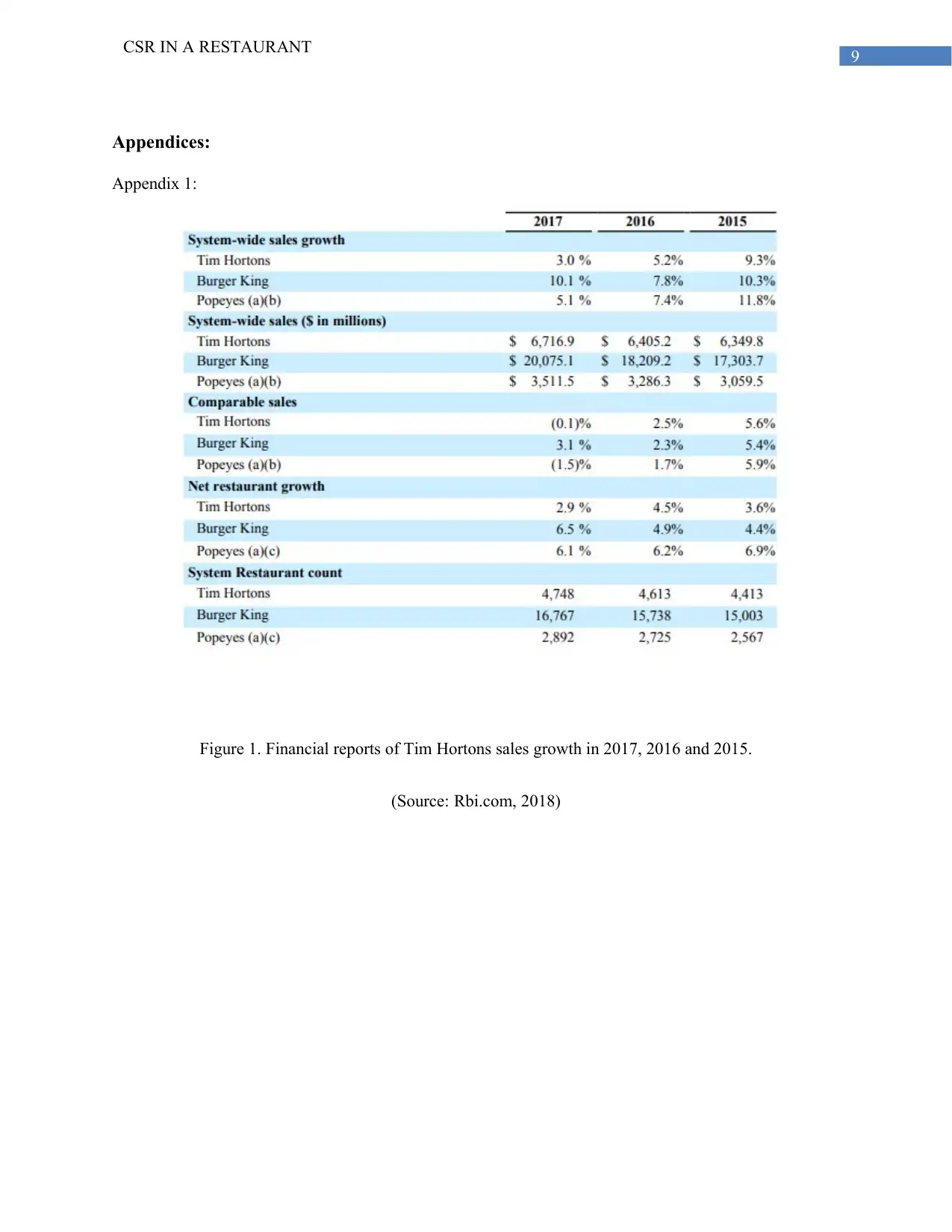
9
CSR IN A RESTAURANT
Appendices:
Appendix 1:
Figure 1. Financial reports of Tim Hortons sales growth in 2017, 2016 and 2015.
(Source: Rbi.com, 2018)
CSR IN A RESTAURANT
Appendices:
Appendix 1:
Figure 1. Financial reports of Tim Hortons sales growth in 2017, 2016 and 2015.
(Source: Rbi.com, 2018)
Paraphrase This Document
Need a fresh take? Get an instant paraphrase of this document with our AI Paraphraser
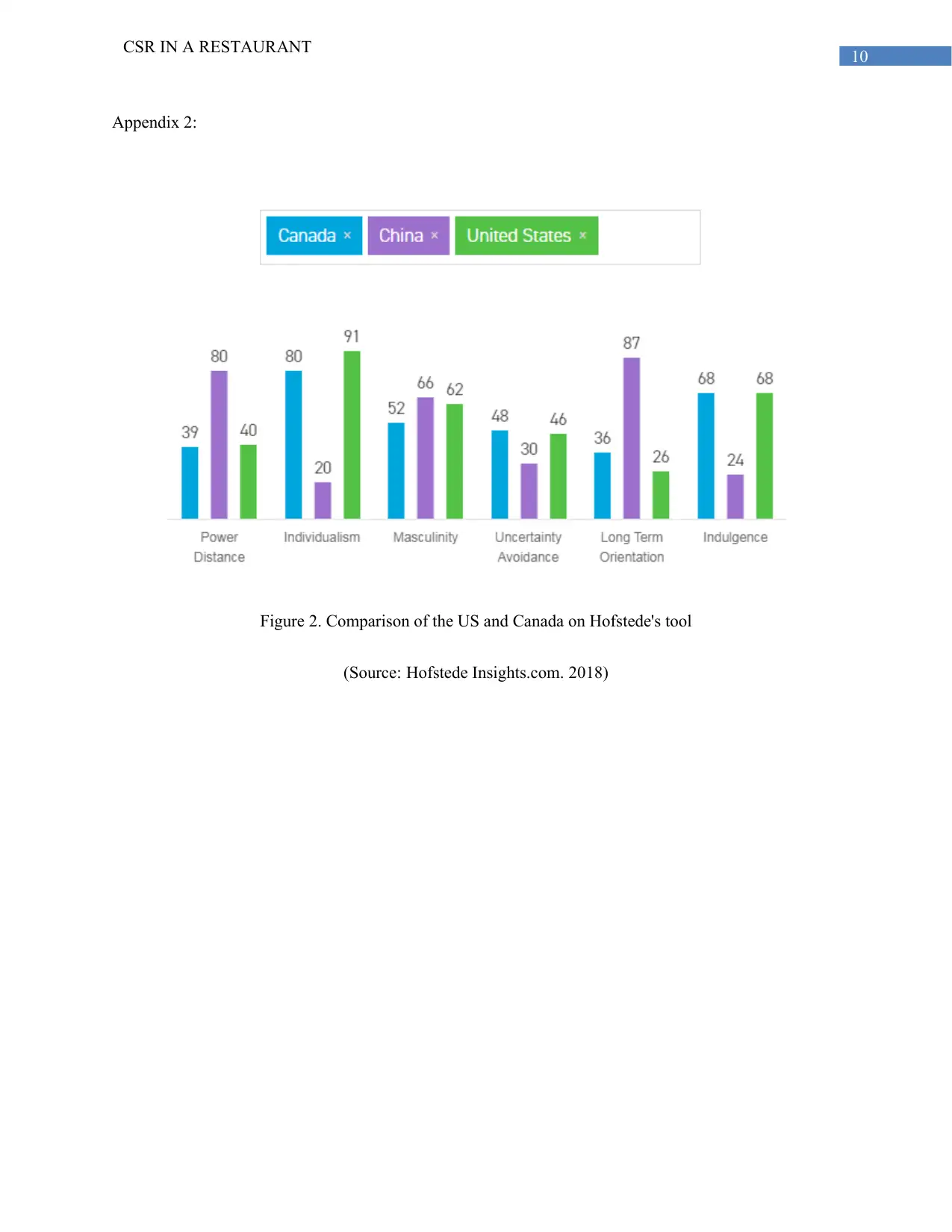
10
CSR IN A RESTAURANT
Appendix 2:
Figure 2. Comparison of the US and Canada on Hofstede's tool
(Source: Hofstede Insights.com. 2018)
CSR IN A RESTAURANT
Appendix 2:
Figure 2. Comparison of the US and Canada on Hofstede's tool
(Source: Hofstede Insights.com. 2018)
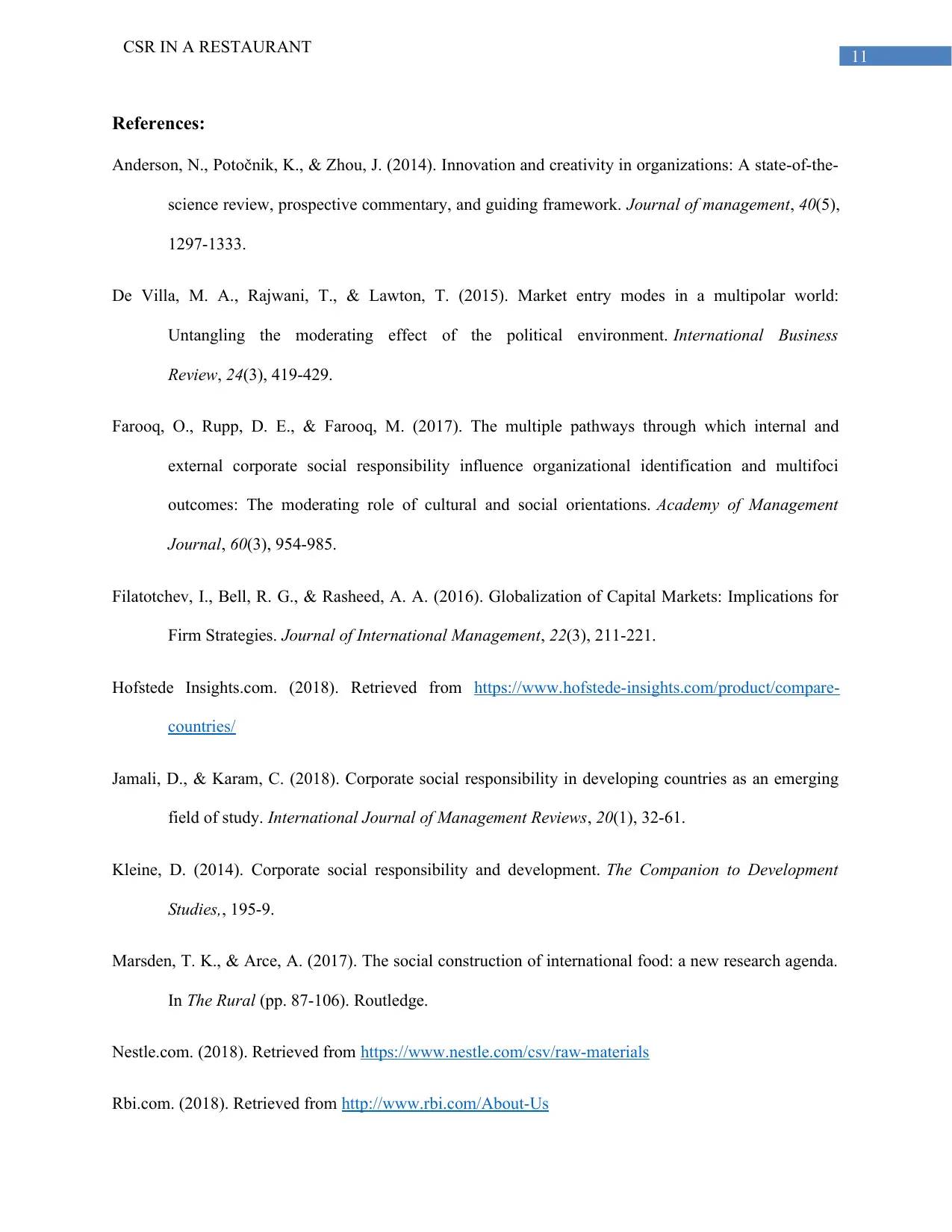
11
CSR IN A RESTAURANT
References:
Anderson, N., Potočnik, K., & Zhou, J. (2014). Innovation and creativity in organizations: A state-of-the-
science review, prospective commentary, and guiding framework. Journal of management, 40(5),
1297-1333.
De Villa, M. A., Rajwani, T., & Lawton, T. (2015). Market entry modes in a multipolar world:
Untangling the moderating effect of the political environment. International Business
Review, 24(3), 419-429.
Farooq, O., Rupp, D. E., & Farooq, M. (2017). The multiple pathways through which internal and
external corporate social responsibility influence organizational identification and multifoci
outcomes: The moderating role of cultural and social orientations. Academy of Management
Journal, 60(3), 954-985.
Filatotchev, I., Bell, R. G., & Rasheed, A. A. (2016). Globalization of Capital Markets: Implications for
Firm Strategies. Journal of International Management, 22(3), 211-221.
Hofstede Insights.com. (2018). Retrieved from https://www.hofstede-insights.com/product/compare-
countries/
Jamali, D., & Karam, C. (2018). Corporate social responsibility in developing countries as an emerging
field of study. International Journal of Management Reviews, 20(1), 32-61.
Kleine, D. (2014). Corporate social responsibility and development. The Companion to Development
Studies,, 195-9.
Marsden, T. K., & Arce, A. (2017). The social construction of international food: a new research agenda.
In The Rural (pp. 87-106). Routledge.
Nestle.com. (2018). Retrieved from https://www.nestle.com/csv/raw-materials
Rbi.com. (2018). Retrieved from http://www.rbi.com/About-Us
CSR IN A RESTAURANT
References:
Anderson, N., Potočnik, K., & Zhou, J. (2014). Innovation and creativity in organizations: A state-of-the-
science review, prospective commentary, and guiding framework. Journal of management, 40(5),
1297-1333.
De Villa, M. A., Rajwani, T., & Lawton, T. (2015). Market entry modes in a multipolar world:
Untangling the moderating effect of the political environment. International Business
Review, 24(3), 419-429.
Farooq, O., Rupp, D. E., & Farooq, M. (2017). The multiple pathways through which internal and
external corporate social responsibility influence organizational identification and multifoci
outcomes: The moderating role of cultural and social orientations. Academy of Management
Journal, 60(3), 954-985.
Filatotchev, I., Bell, R. G., & Rasheed, A. A. (2016). Globalization of Capital Markets: Implications for
Firm Strategies. Journal of International Management, 22(3), 211-221.
Hofstede Insights.com. (2018). Retrieved from https://www.hofstede-insights.com/product/compare-
countries/
Jamali, D., & Karam, C. (2018). Corporate social responsibility in developing countries as an emerging
field of study. International Journal of Management Reviews, 20(1), 32-61.
Kleine, D. (2014). Corporate social responsibility and development. The Companion to Development
Studies,, 195-9.
Marsden, T. K., & Arce, A. (2017). The social construction of international food: a new research agenda.
In The Rural (pp. 87-106). Routledge.
Nestle.com. (2018). Retrieved from https://www.nestle.com/csv/raw-materials
Rbi.com. (2018). Retrieved from http://www.rbi.com/About-Us
⊘ This is a preview!⊘
Do you want full access?
Subscribe today to unlock all pages.

Trusted by 1+ million students worldwide
1 out of 13
Related Documents
Your All-in-One AI-Powered Toolkit for Academic Success.
+13062052269
info@desklib.com
Available 24*7 on WhatsApp / Email
![[object Object]](/_next/static/media/star-bottom.7253800d.svg)
Unlock your academic potential
Copyright © 2020–2025 A2Z Services. All Rights Reserved. Developed and managed by ZUCOL.





